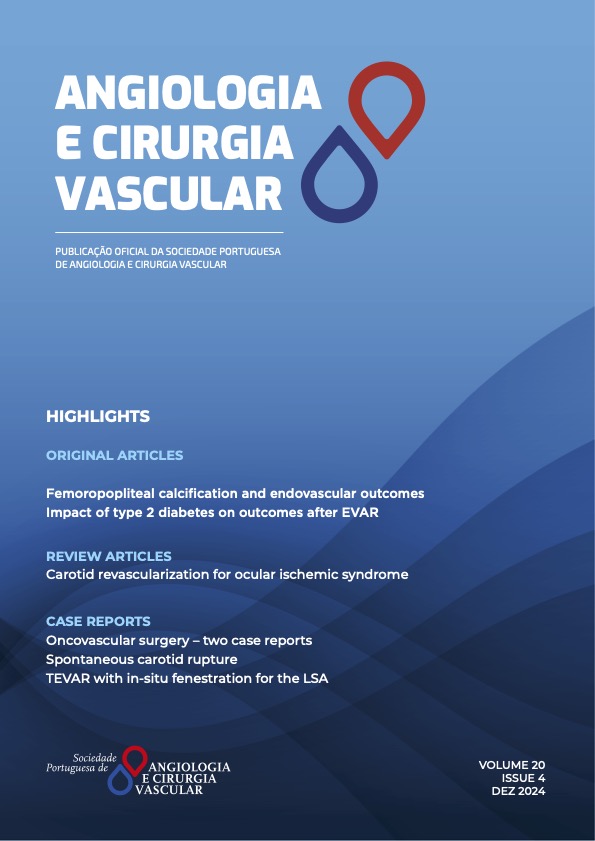Carotid revascularization for ocular ischemic syndrome – a systematic review
DOI:
https://doi.org/10.48750/acv.612Keywords:
Carotid artery, Carotid endarterectomy, Carotid surgery, Ocular hypoperfusion, Ocular ischemic syndrome, Visual outcomesAbstract
INTRODUCTION: The link between extracranial carotid artery disease and visual symptoms is well-established, with amaurosis fugax as a precursor to retinal transient ischemic attacks (TIAs). The presence of cholesterol emboli and fibrin-platelet aggregates in retinal circulation has shown carotid plaque embolization leading to TIAs and strokes. However, not all visual symptoms are embolism related. Ocular ischemic syndrome (OIS) due to hypoperfusion is another potential consequence. This can manifest as visual symptoms similar to classic amaurosis fugax, where severe occlusive carotid lesions may cause ocular hypoperfusion rather than emboli. We aim to study the potential improvement of visual symptoms post-carotid endarterectomy (CEA) in patients with carotid stenosis and hypoperfusion-related ocular issues.METHODS: We conducted a systematic review of the literature through PubMed and Embase databases using PICO-based keywords: (ocular ischemia OR ocular hypoperfusion*) AND (carotid endarterectomy* OR carotid surgery*) AND (outcomes*). PRISMA guidelines were followed. After removing duplicates and screening, nine were selected for inclusion through meticulous review and reference list examination. The primary outcome assessed postoperative visual improvement, while the secondary outcome focused on ocular blood flow augmentation.
RESULTS: The impact of CEA on visual functions and ocular blood flow in patients with OIS has been investigated in nine studies with a total of 545 patients. Clouse et al. reported that patients with OIS and symptomatic eyes had worse ipsilateral internal carotid artery stenosis. Subjective visual improvement or stabilization following CEA was observed in 40-100% of the symptomatic patients across the studies. Regarding the impact of CEA on ocular blood flow (OBF) and visual function in patients with carotid disease, the peak systolic velocity (PSV) increased significantly in the orbital artery (OA) and central retinal artery (CRA), after CEA. Cohn et al. showed that patients with OIS had significantly lower preoperative PSVs in the CRA than those without visual symptoms. In a study comparing CEA and medical therapy for patients with OIS and significant carotid disease, Yan et al. found that CEA was significantly more effective.
CONCLUSIONS: CEA can improve visual function and alleviate ocular hypoperfusion-related symptoms in patients with carotid artery stenosis. The findings highlight CEA's potential as a therapeutic intervention for enhancing visual outcomes in these patients. Further research is needed to determine specific indications for CEA in patients with OIS.
Downloads
References
Terelak-Borys B, Skonieczna K, Grabska-Liberek I. Ocular ischemic syndrome - a systematic review. Med Sci Monit. 2012;18:Ra138-44.
Chen CS, Miller NR. Ocular ischemic syndrome: review of clinical presentations, etiology, investigation, and management. Compr Ophthalmol Update. 2007;8:17-28.
Page MJ, McKenzie JE, Bossuyt PM, Boutron I, Hoffmann TC, Mulrow CD, et al. The PRISMA 2020 statement: an updated guideline for reporting systematic reviews. BMJ. 2021;372:n71.
Clouse WD, Hagino RT, Chiou A, DeCaprio JD, Kashyap VS. Extracranial cerebrovascular revascularization for chronic ocular ischemia. Ann Vasc Surg. 2002;16:1-5.
Kawaguchi S, Okuno S, Sakaki T, Nishikawa N. Effect of carotid endarterectomy on chronic ocular ischemic syndrome due to internal carotid artery stenosis. Neurosurgery. 2001;48:328-32; discussion 332-3.
Neroev VV, Kiseleva TN, Vlasov SK, Pak NV, Gavrilenko AV, Kuklin AV. Visual outcomes after carotid reconstructive surgery for ocular ischemia. Eye (Lond). 2012;26:1281-7.
Yan Y, Zhang X, Yang Y, Han L, Wang H, Hu J. Analysis and curative effect of ocular ischemic diseases caused by carotid artery stenosis. Exp Ther Med. 2013;5:1310-4.
Sivalingam A, Brown GC, Magargal LE. The ocular ischemic syndrome. III. Visual prognosis and the effect of treatment. Int Ophthalmol. 1991;15:15-20.
Cohn EJ Jr, Sandager GP, Benjamin ME, Lilly MP, Hanna DJ, Flinn WR. Assessment of ocular perfusion after carotid endarterectomy with color-flow duplex scanning. J Vasc Surg. 1999;29:665-71.
Yoshida S, Oya S, Obata H, Fujisawa N, Tsuchiya T, Nakamura T, et al. Carotid endarterectomy restores decreased vision due to chronic ocular ischemia. Acta Neurochir (Wien). 2021;163:1767-75.
Geroulakos G, Botchway LT, Pai V, Wilkinson AR, Galloway JM. Effect of carotid endarterectomy on the ocular circulation and on ocular symptoms unrelated to emboli. Eur J Vasc Endovasc Surg. 1996;11:359-63.
Yan J, Yang X, Wu J, Liu B, Jiao X, Li W, et al. Visual Outcome of Carotid Endarterectomy in Patients with Carotid Artery Stenosis. Ann Vasc Surg. 2019;58:347-56.
Naylor R, Rantner B, Ancetti S, de Borst GJ, De Carlo M, Halliday A, et al. Editor's Choice - European Society for Vascular Surgery (ESVS) 2023 Clinical Practice Guidelines on the Management of Atherosclerotic Carotid and Vertebral Artery Disease. Eur J Vasc Endovasc Surg. 2023;65:7-111.









